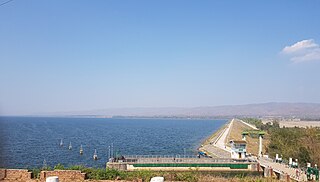
The Bakun Dam is an embankment dam located in Belaga District, Kapit Division, Sarawak, Malaysia, on the Balui River, a tributary or source of the Rajang River and some sixty kilometres east of Belaga. As part of the project, the second-tallest concrete-faced rockfill dam in the world would be built. It would generate 2,400 megawatts (MW) of electricity once completed.

Burqin County is a county in Xinjiang, China and is under the administration of the Kazakh autonomous area of Altay Prefecture. It has an area of 10,362 km2 (4,001 sq mi) with a population of 70,000. The postcode is 836600.
The Baihetan Dam is a large hydroelectric dam on the Jinsha River, an upper stretch of the Yangtze River in Sichuan and Yunnan provinces, in southwest China. The dam is a 289-meter-tall double-curvature arch dam with a crest elevation of 827 m, and a width of 72 m at the base and 13 m at the crest. It is considered to be the last large hydropower project in China after a series of projects starting with the Three Gorges Dam. It is also the second largest hydropower plant in the world. The hydropower station is equipped with 16 hydro-generating units each having a capacity of 1 million kilowatts, the world's largest turbines. All hydro-generating units of the Baihetan hydropower station became fully operational on 20 December 2022.

China Yangtze Power Co., Ltd. (CYPC), known as Yangtze Power is a Chinese utilities company, headquartered in Beijing. The company is a component of SSE 180 Index. A controlling share is held by the parent company China Three Gorges Corporation, a state-owned enterprise under State-owned Assets Supervision and Administration Commission of the State Council.

The Murum Dam is a gravity dam on the Murum River in Sarawak, Malaysia. Construction began in 2008, the dam's reservoir began to fill in July 2013 and the first generator was commissioned in December 2014. The fourth and final turbine became operational on 8 June 2015. Concerns have been raised about the displacement of the Dayak people and the removal of rainforest due to the construction of the dam.

China Gezhouba Group Company Limited is a Chinese construction and engineering company based in Wuhan, Hubei. As of 2014, the company is the 33rd largest contractor by revenue in the world. The major shareholder of the company (40.8%) is state-owned China Gezhouba Group Corporation, which is in turn a subsidiary of the China Energy Engineering Corporation.

There are almost 200 large dams in Myanmar. Myanmar (Burma) has a large hydroelectric power potential of 39,000 megawatts (52,000,000 hp), although the economical exploitable potential is about 37,000 megawatts (50,000,000 hp). Between 1990 and 2002, the country tripled its installed capacity of hydro plants, increasing from 253 megawatts (339,000 hp) to 745 megawatts (999,000 hp). Total installed capacity in 2010 is at least 2,449 megawatts (3,284,000 hp) MW, 6% of potential. Several large dams are planned to increase future hydro utilization.

The Karuma Hydroelectric Power Station is a 600 MW hydroelectric power project under construction in Uganda. When completed, it will be the largest power-generating installation in the country.
Ayago Hydroelectric Power Station, also Ayago Power Station, is a planned 840 megawatt hydroelectric power project to be constructed in Uganda. If it is built, Ayago would be the largest power station in Uganda, based on generating capacity.
The China Three Gorges Corporation is a Chinese state-owned power company, established on 27 September 1993. The company was responsible for the construction of the Three Gorges Dam-project, the world's largest hydroelectric power plant, that went into operation in 2008. In September 2002, CTG established the subsidiary company China Yangtze Power, which took over operations and management of Gezhouba and Three Gorges dams. CTG is one of the world's largest energy companies with total assets of RMB 475.5 billion in 2014. Other than hydroelectric dams, the company also operates onshore and offshore wind farms.
China International Water & Electric Corporation is a Chinese construction and engineering consulting company that is a subsidiary of China Three Gorges Corporation (CTE). CWE specializes in the construction of water and hydropower projects but its work runs the gamut including road and bridge, power transmission, drainage and sewage treatment systems, dredging, port maintenance, and interior design.
The Burqin Shankou Dam is an arch dam in Burqin County of Xinjiang Uighur Autonomous Region of China.

Hydroelectricity is currently China's largest renewable energy source and the second overall after coal. According to the International Hydropower Association, China is the worlds largest producer of hydroelectricity as of 2021. China's installed hydroelectric capacity in 2021 was 390.9 GW, including 36.4 GW of pumped storage hydroelectricity capacity, up from 233 GW in 2011. That year, hydropower generated 1,300 TWh of power, an increase of 68 TWh over 2018 when hydropower generated 1,232 TWh of power, accounting for roughly 18% of China's total electricity generation.
Kiba Hydroelectric Power Station is a proposed 295 megawatts (396,000 hp) hydroelectric power station in Uganda.

The Nam Ou cascade hydropower project is a series of seven hydroelectric dams along the Nam Ou river which are located in the provinces of Phongsaly and Luang Prabang in northern Laos. The project is managed by the Power Construction Corporation of China (PowerChina) and the Lao government. The project is the series of dams include seven levels of reservoirs in an attempt to mitigate ecological deterioration. The construction of the hydropower project is being completed in two phases. Phase I of the dams, including Nam Ou 2, Nam Ou 5, and Nam Ou 6 began operating on May 12, 2016. Phase II of the dams, including Nam Ou 1, 3, 4, and 7 is expected to be completed in 2020.
Kafue Gorge Lower Power Station (KGL), is a 750 megawatts (1,010,000 hp) hydroelectric power station in Zambia.









